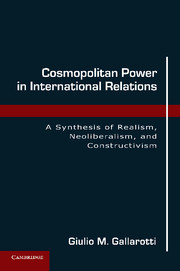 Cosmopolitan Power in International Relations
Cosmopolitan Power in International Relations Book contents
- Frontmatter
- Contents
- Preface
- Introduction
- 1 The Theory of Cosmopolitan Power
- 2 Crucial-Case Textual Analysis of the Founding Fathers of Realism
- 3 Crucial-Case Textual Analysis of the Founding Fathers of Realism
- 4 Case Studies of Soft Empowerment
- 5 Case Study of Hard Disempowerment
- 6 Case Study of Soft Empowerment
- 7 Conclusions
- Appendix Formal Model of Cosmopolitan Power
- References
- Index
5 - Case Study of Hard Disempowerment
U.S. Foreign Policy and the Bush Doctrine
Published online by Cambridge University Press: 05 June 2012
- Frontmatter
- Contents
- Preface
- Introduction
- 1 The Theory of Cosmopolitan Power
- 2 Crucial-Case Textual Analysis of the Founding Fathers of Realism
- 3 Crucial-Case Textual Analysis of the Founding Fathers of Realism
- 4 Case Studies of Soft Empowerment
- 5 Case Study of Hard Disempowerment
- 6 Case Study of Soft Empowerment
- 7 Conclusions
- Appendix Formal Model of Cosmopolitan Power
- References
- Index
Summary
U.S. foreign policy under the George W. Bush administration represents an especially crucial case laboratory for the analysis of the process of hard disempowerment. First, the United States enjoyed global primacy with respect to hard power under the Bush years. Although a number of naysayers identified a deterioration of the relative power position of the United States during these years, few have questioned whether the United States had enjoyed a preponderant position of global influence. Moreover, because the Bush Doctrine vigorously embraced the use of hard power strategies at the expense of soft power strategies in promoting critical foreign policy goals, it is an especially critical case for assessing how an exaggerated dependence on hard power can be disempowering in the modern world system.
The Bush Doctrine and Hard Power
Although George W. Bush campaigned on promises of a “humble foreign policy,” events that would confront the fledgling president called off all bets. After 9/11, the United States embarked on a new course in global affairs, one that painstakingly and autonomously sought to blaze a crusading trail that would leave those who menaced Americans charred in its path. According to Bush, the new threats to the American people (“radicalism” and “technology”) created conditions that altered American foreign priorities (White House 2002a, 3). This, in turn, called for new solutions. Whereas grand diplomacy and alliances had been the appropriate methods to confront security threats in the old world of international politics, the new world of terrorism and proliferating WMD vitiated the effectiveness of these cumbersome and slow strategies. The new threats called for anticipation, speed, and resolve, none of which accorded with the lethargic processes of international organization or activation of alliance commitments in the face of threats. The strategy must be to “destroy threats before they reach [American] shores,” which would necessitate that Americans “not hesitate to act alone, if necessary, to exercise [their] right of self defense” (White House 2002a, 6). Moreover, as Bush proclaimed in the National Security Strategy (2002a, iv) and reiterated in the preface to the National Strategy to Combat Weapons of Mass Destruction (White House 2002b, 1), “the only path to peace and security is the path of action.” Indeed, the premise of Bush's national security strategy was that “America is at war,” so it was a “wartime national strategy” (White House 2006, i). In war, the United States could not afford to be passive. The policy mandated an unapologetic imposition of U.S. will and thus was strongly grounded in an orientation of assertive nationalism. This strategy was dubbed the Bush Doctrine. The doctrine designated vigorous use of American power and unilateralism as the foundations on which to construct a more effective style of American foreign policy.
- Type
- Chapter
- Information
- Cosmopolitan Power in International RelationsA Synthesis of Realism, Neoliberalism, and Constructivism, pp. 180 - 225Publisher: Cambridge University PressPrint publication year: 2010


